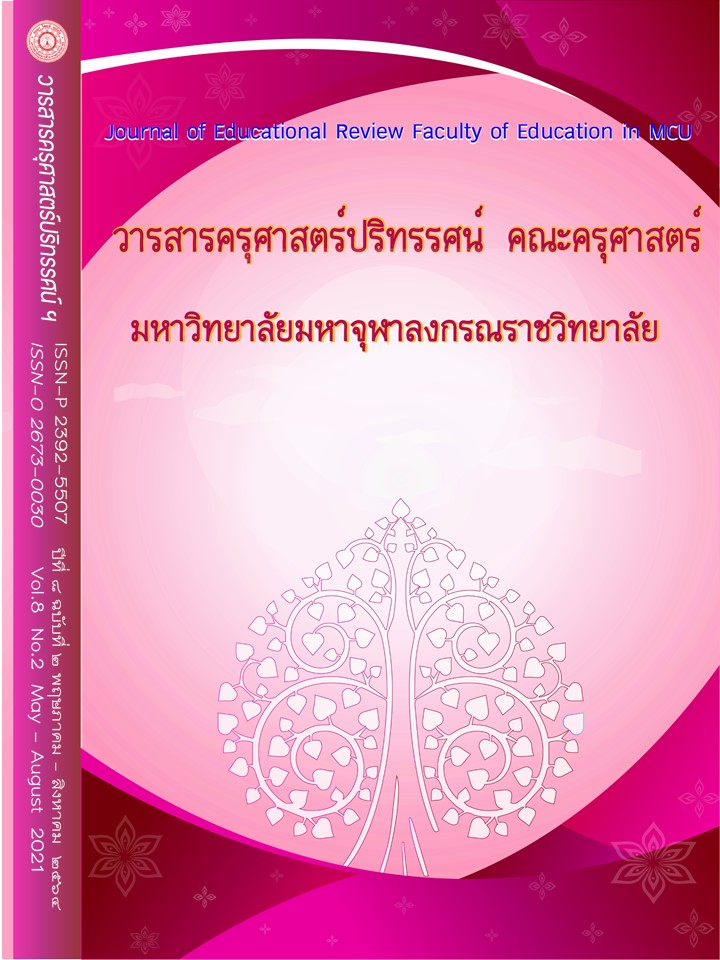THE STRATEGIES OF SUSTAINABLE DESTINATION DEVELOPMENT IN PHRANAKHON SI AYUTTHAYA PROVINCE
Main Article Content
Abstract
The objectives of this research paper were 1) to study the current situation of tourist destination in Phra Nakhon Si Ayutthaya Province, 2) to study the principles of filling in the Sustainable Development Goals, 3) to study the sustainable tourism practices for tourist sites, 4) to formulate a strategy of sustainable tourist destination development. Mixed methods research that combines methods with quantitative research and qualitative research was conducted. The population and sample used in this research were stakeholders from 23 in tourist sites in Ayutthaya province, and purposive sampling was used. The research tools were survey form, in-depth interview form, questionnaires, and strategic assessment from. Qualitative data was analyzed by content analysis. The quantitative data were analyzed by descriptive statistics such as percentage, frequency, mean and standard deviation. Results of the research were summarized as follows: 1) the current situation of tourist destination in Phra Nakhon Si Ayutthaya Province were (1) external environmental factors showed in overall at moderate level, and (2) internal environmental factors showed in overall was at a moderate level. 2) Principles for filling in the Sustainable Development Goals showed in overall at a high level, namely, cooperation for sustainable development at the highest level. For the economy and wealth Social and human dignity and the environment and nature were at high levels. 3) The sustainable tourism practices for tourist sites showed that in overall at a high level, namely the aspect of increasing economic benefits to the community, enhancing benefits to the environment and an overview of sustainability management at a high level. For adding benefits to the community tourists and cultural heritage was at moderate level. 4) A strategy of sustainable tourist destination development in Ayutthaya Province consisted of 5 main strategies, which were 1) core strategy for the new transformation concept, 2) core strategy for the engagement concept, 3) core strategy for the main sustainable management concept, 4 ) core strategy for integration concepts, 5) core strategy for moral and ethical concepts.
Article Details
ทัศนะและความคิดเห็นที่ปรากฏในบทความในวารสารฉบับนี้ถือเป็นความรับผิดชอบของผู้เขียนบทความนั้นเพียงผู้เดียว และไม่ถือเป็นทัศนะและความรับผิดชอบของกองบรรณาธิการ
กองบรรณาธิการขอสงวนสิทธิ์ในการคัดเลือกบทความลงตีพิมพ์และจะแจ้งให้เจ้าของบทความทราบหลังจากผู้ประเมินบทความตรวจอ่านบทความแล้ว
ต้นฉบับที่ได้รับการตีพิมพ์ในวารสารครุศาสตร์ปริทรรศน์ คณะครุศาสตร์ มหาวิทยาลัยมหาจุฬาลงกรณราชวิทยาลัย ถือเป็นกรรมสิทธิ์ของคณะครุศาสตร์ มหาวิทยาลัยมหาจุฬาลงกรณราชวิทยาลัย ห้ามนำข้อความทั้งหมดหรือบางส่วนไปพิมพ์ซ้ำ เว้นเสียแต่ว่าจะได้รับอนุญาตจากมหาวิทยาลัยฯ เป็นลายลักษณ์อักษร
References
กระทรวงการท่องเที่ยวและกีฬา. (2564). สถานการณ์การท่องเที่ยวในประเทศ รายจังหวัด ปี 2564. แหล่งที่มา https://www.mots.go.th/more_news_new.php?cid=630 สืบค้นเมื่อ 10 ก.พ. 2564.
กิตติกรณ์ สมยศ และคณะ. (2562). การพัฒนาศักยภาพรองรับการท่องเที่ยวของชุมชนในเขตพื้นที่เมืองเก่าน่าน. รายงานการวิจัย. วิทยาลัยชุมชนน่าน.
จักรวาล สุขไมตรี. (2561). เทคนิคการประสานงานในองค์การ. วารสารวิชาการแพรวากาฬสินธุ์ มหาวิทยาลัยกาฬสินธุ์. 5(2). 263-267.
ตลาดหลักทรัพย์แห่งประเทศไทย. (2560). หลักการกำากับดูแลกิจการที่ดี สำหรับบริษัทจดทะเบียน ปี 2560 Corporate Governance Code. แหล่งที่มา https://www.sec.or.th/TH/Documents/CompanyHandbooksandGuidelines/CGcode2560_th.pdf สืบค้นเมื่อ 12 เม.ย. 2564.
ตลาดหลักทรัพย์แห่งประเทศไทย. (2564). แนวปฏิบัติด้านการกำกับดูแลกิจการที่ดี เรื่อง การจัดทำจรรยาบรรณธรุกิจ (Code of Conduct). แหล่งที่มา https://www.setsustainability.com/download/nhy6ilabqup71cv สืบค้นเมื่อ 10 ก.พ. 2564.
ธนรัตน์ รัตนพงศ์ธระ, เสรี วงษ์มณฑา, ชุษณะ เตชคณา และณัฐพล ประดิษฐผลเลิศ. (2559). แนวทางการพัฒนาการท่องเที่ยวเชิงมรดกวัฒนธรรมในจังหวัดพระนครศรีอยุธยา. วารสารวิชาการนวัตกรรมสื่อสารสังคม. 4(2). 34-45.
ประมวลจริยธรรมข้าราชการพลเรือน. (2564). ราชกิจจานุเบกษา เล่ม 138 ตอนพิเศษ 109 ง หน้า 8 (20 พ.ค. 2564).
ปรารถนา สถิตวิภาว, และคณะ. (2556). รายงานการวิจัยเรื่องโครงการศึกษาการพฒนาศักยภาพด้านการจัดการพื้นที่และทรัพยากรเพื่อการส่งเสริมการท่องเที่ยวอยางยั่งยืน. แหล่งที่มา http://library.senate.go.th/document/Ext7670/7670878_0011.PDF สืบค้นเมื่อ 10 ต.ค. 2563.
พงษ์ศักดิ์ เพชรสถิต, บุญทัน ดอกไธสง และวิมล หอมยิ่ง. (2558). ยุทธศาสตร์การบริหารจัดการการท่องเที่ยวอย่างยั่งยืนของจังหวัดกำแพงเพชร. สักทอง: วารสารมนุษยศาสตร์และสังคมศาสตร์. 21(2). 173-168.
เพ็ญประภา เพชระบูรณิน และศศิธร ป้องเรือ. (2557). การบริหารจัดการสิ่งแวดล้อมของแหล่งท่องเที่ยวทางประวัติศาสตร์ จังหวัดนครพนม ตามแนวทางการท่องเที่ยวเชิงอนุรักษ์. วารสารวิชาการการท่องเที่ยวไทยนานาชาติ. 10(2). 74-86.
ภัทรา แจ้งใจเจริญ. (2559). การจัดการการท่องเที่ยวเชิงวัฒนธรรม กรณีศึกษา ชุมชนโอหงิมาจิ หมู่บ้านชิราคาว่าโก จังหวัดกิฝุ ประเทศญี่ปุ่น. วารสารญี่ปุ่นศึกษา. 33(2). 79-97.
ศูนย์บริหารสถานการณ์แพร่ระบาดของโรคติดเชื้อไวรัสโคโรนา 2019 กระทรวงมหาดไทย (ศบค.มท.). (2564). การแพร่ระบาดของโคโรนาไวรัส (COVID-19). แหล่งที่มา https://www.moicovid.com/ สืบค้นเมื่อ 10 ก.พ. 2564.
สถาบันวิทยาการนวัตกรรม. (2564). 5 เทรนด์นวัตกรรมเพื่อการท่องเที่ยวที่น่าจับตามองในยุค New Normal. แหล่งที่มา https://moocs.nia.or.th/article/5-new-normal-travel-trends สืบค้นเมื่อ 10 ม.ค. 2564.
สมจิตร์ อินทมโน และปาริชาติ วิสุทธิสมาจาร. (2557). การท่องเที่ยวเชิงประวัติศาสตร์: กรณีศึกษาลุ่มน้ำทะเลสาบสงขลา. รายงานวิจัย. มหาวิทยาลัยสงขลานครินทร์ วิทยาเขตหาดใหญ่.
สมศักดิ์ ตันติเศรณี. (2560). การพัฒนาการท่องเที่ยวเชิงวัฒนธรรมของย่านเมืองเก่าในเขตเทศบาลนครสงขลา. ดุษฎีนิพนธ์ปรัชญาดุษฎีบัณฑิต. มหาวิทยาลัยทักษิณ.
สามารถ จับโจร, เปรมวิทย์ ท่อแก้ว, ธนชัย พรหมรัตน์ และอาวุธ คันศร. (2562). แนวทางการจัดการการท่องเที่ยวที่เหมาะสำหรับนักท่องเที่ยว กลุ่มผู้สูงอายุภายใต้บริบทพื้นที่ภาคตะวันออกเฉียงเหนือตอนล่าง. วารสารวิจัยและพัฒนา มหาวิทยาลัยราชภัฏบุรีรัมย์. 15(1). 64-80.
สำนักงานคณะกรรมการกฤษฎีกา. (2546). พระราชกฤษฎีกาว่าด้วยหลักเกณฑ์และวิธีการบริหารกิจการบ้าน เมืองที่ดี พ.ศ. 2546 ราชกิจจานุเบกษาเล่ม 120/ตอนที่ 100 ก/หน้า 1/9 ตุลาคม 2546. แหล่งที่มา http://web.krisdika.go.th/data/law/law2/%C338/%C338-2a-2546-a0002.htm สืบค้นเมื่อ 10 ม.ค. 2564.
สำนักงานคณะกรรมการพัฒนาการเศรษฐกิจและสังคมแห่งชาติ. (2559). แผนพัฒนาเศรษฐกิจและสังคมแห่งชาติ ฉบับที่สิบสอง พ.ศ. 2560 – 2564. จาก https://www.nesdc.go.th/ewt_dl_link.php?nid=6422 สืบค้นเมื่อ 10 ก.พ. 2564.
สำนักงานจังหวัดพระนครศรีอยุธยา. (2560). แผนพัฒนาจังหวัด 5 ปี (พ.ศ. 2561 – 2565) (ฉบับทบทวน ปี พ.ศ. 2564). แหล่งที่มา http://www.ayutthaya.go.th/strategic/FileData/pdf/new_140520150110.pdf สืบค้นเมื่อ 10 ก.พ. 2564
สำนักงานพัฒนารัฐบาลดิจิทัล. (2563). แผนพัฒนารัฐบาลดิจิทัลปี 2021. แหล่งที่มา https://www.dga.or.th/document-sharing/dg2021/ สืบค้นเมื่อ 10 เม.ย. 2564.
สุจิตต์ วงษ์เทศ. (2546). อยุธยายศยิ่งฟ้า. พิมพ์ครั้งที่ 2. กรุงเทพมหานคร: มติชน.
สุภา สังขวรรณ. (2560). กลยุทธ์การพัฒนาแหล่งท่องเที่ยวเชิงอนุรักษ์ในจังหวัดสมุทรสงคราม. วารสารวิทยาการจัดการ มหาวิทยาลัยราชภัฏนครปฐม. 4(1). 1-9.
Ehinger, Lindsey T. (2016). Kyrgyzstan's community-based tourism industry: A model method for sustainable development and environmental management. University of Wyoming
Faludi, Jeremy. (2017). Golden Tools in Green Design: What Drives Sustainability, Innovation and Value in Green Design Methods. University of California.
Gabriela, Estrella. Myrta, Zemp. & Urs, Wagenseil. (2014). Corporate Social Responsibility : building excellence in sustainable tourism education network Corporate Responsibility in Tourism-Standards Practices and Policies. From https://www.besteducationnetwork.org/TTXIV_Agenda Retrieved April 11, 2021.
Gandip, K.C. (2013). Environmental management and sustainable tourism development in the annapurna region. nepal. Centria university of applied sciences.
Hamburger, Jennifer P. (2021). The Collaborative Process Between Communities and Local Government: The Public Administrator’s Responsibility. Capella University.
Huan huan Hua., Wondirad Amare. (2021). Tourism Network in Urban Agglomerated Destinations: Implications for Sustainable Tourism Destination Development through a Critical Literature Review. Sustainability Basel. 13(1).
Katavic, Ivica. (2014). Corporate social responsibility and sustainable competitive advantage: A case study of the cement industry. Northcentral University.
Koenig, Eric S. (2016). Baiting Sustainability: Collaborative Coastal Management, Heritage Tourism and Alternative Fisheries in Placencia. Belize. University of South Florida.
Krejcie and D. Morgan. (1970). Determining Sample Size Research Activities. Educational and Psychological Measurement. 30. 607-610.
Likert, Rensis. (1967). The Method of Constructing and Attitude Scale. Reading in Attitude Theory and Measurement. Fishbeic, Matin, Ed. New York: Wiley & Son.
Mechelle, Nicole. Best. (2008). Environmental management in the accommodations sector in the anglophone caribbean. University of Florida.
Ramteke, Sachin K. (2019). Innovation Strategies for a Global Manufacturing Business. Walden University.
Ruhanen, Lisa. (2010). Where's the Strategy in Tourism Strategic Planning? Implications for Sustainable Tourism Destination Planning. Journal of Travel and Tourism Research. Kusadasi-Avdin. 58-76.
Srisung, P. and Chompunth, C. (2020). Waste Management According to the Sustainable Development Goal 12: A Case Study of Chang Island in Trat Province. From https://so04.tci-thaijo.org/index.php/colakkujournals/article/download/246643/168827/ Retrieved January 10, 2021.
UNWTO. (2015). TOURISM IN THE 2030 AGENDA. From https://www.unwto.org/tourism-in-2030-agenda Retrieved September 10, 2020.


